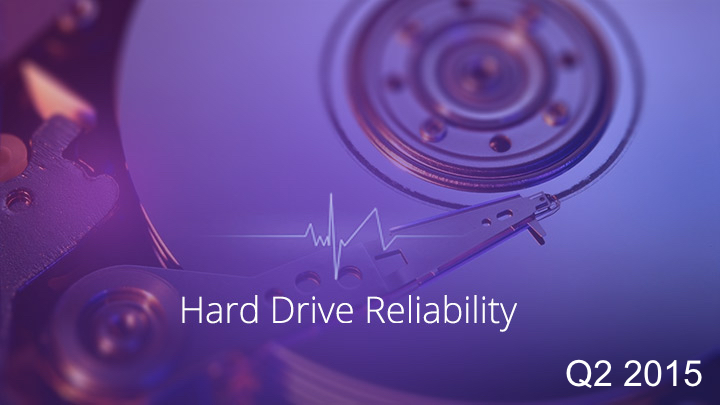
Each quarter, Backblaze updates our hard drive statistics with the latest data. As of the end of Q2 2015, there were 47,561 drives spinning in our data center. Subtracting out boot drives, drive models with less than 45 drives and drives in testing systems, we are publishing data on 46,038 hard drives spread across 21 different models, from 1.5TB to 8TB in size.
All the hard drives in this review are used in the production systems in our data center. The environment is climate controlled and all drives are individually monitored. Each day we pull the available SMART stats reported by each and every drive. These stats are available for download from our Hard Drive Data webpage.
There are two SMART stats of particular interest for most folks: hours in operation and drive temperature. The SMART 9 attribute allows us to compute the age of the drive, and the SMART 194 attribute allows us to determine that all drives are within their acceptable temperature range. Downloading the data will enable you to examine the SMART stats for every drive we used in this review.
Hard Drive Failure Rates
We’ll start by comparing the hard drive reliability stats for the January-June 2015 period with the stats from 2014:
Trends in Hard Drive Failure Rates
The following table presents the cumulative hard drive reliability stats over time. This table can provide insights into failure rate trends as the drive population ages:
What Is a Failed Hard Drive?
For Backblaze, there are three reasons a drive is considered to have “failed:”
- The drive will not spin up or connect to the OS.
- The drive will not sync, or stay synced, in a RAID array (see note below).
- The SMART stats we use show values above our thresholds.
Note: Backblaze Vaults do not use RAID. Instead, we use our open-sourced implementation of Reed-Solomon encoding to replace the function of RAID. As a result, these drives are not subject to RAID-sync errors. RAID-sync failures are only applicable to stand-alone Storage Pods.
Takeaways
The 4TB drives continue to rock, with both Seagate and HGST 4TB drives performing well. The Seagate 4TB drive has a current cumulative failure rate of 3% and has a street price of $131.58 each on Amazon. The HGST 4TB drive has a higher street price of $174.99 on Amazon, but a lower cumulative failure rate of 1.18%. Both drives have been in service for over a year and we currently own 17,000+ Seagate and 11,000+ HGST 4TB drives and continue to purchase more.
The failure rates of the Toshiba and Western Digital 4TB drives look respectable as well, but they are based on a very limited number of drives for each model. We’ve had trouble getting the Toshiba drives quoted to us in quantity, although there appears to be some movement on that front. Western Digital drives are almost always quoted to us at a higher price than other drive models. Until we can get a reasonable number of these drives, we can’t recommend either of them, although you may find them to be just fine for your personal use.

For 6TB drives, the data is still not firm. We did manage to buy 450 Western Digital 6TB drives that currently have a 6.2% failure rate over the eight months they’ve been in service, but their failure rate has fluctuated over time from 3.07% to 13.75%. The 495 6TB Seagate drives have a lower current failure rate, at 3.8%, but they have been in service less than six months. In summary, more time is needed to get a good fix on the failure rates of these 6TB drives.
Regarding the 8TB drives we have deployed, we need more drives and more time before we can recommend anything. We currently have had 45 HGST 8TB drives (helium) deployed for about one quarter. The current annual failure rate of 5.3% is based on one drive failure, which is certainly not enough to draw any conclusions.
The 1.5TB and 2TB drives we have in production are slowly being replaced with larger capacity drives. The average age of the Seagate 1.5TB drives is over five years, making these some of the oldest drives in our data center. Their current annual failure rate is over 10%, so these drives are being replaced first. The HGST 2TB drives we have running have been exceptional. After four or more years of service, their cumulative failure rate is just 1.9%. If you’re interested in a 2TB drive, the HGST drive (model HDS722020ALA330) has been an all-star performer for us and they are still available on Amazon for $56.43.
As far as 3TB drives go, we have replaced nearly all of our Seagate 3TB drives. If you are interested in getting a 3TB drive, we’ve had a positive experience with the HGST 3TB drive (model HDS723030ALA640) which can still be found in stock on Amazon for $110.88. Their current failure rate in our environment is 1.83%. The HGST 3TB, model HDS5C3030ALA630, is a choice good as well, but quantities seem to be limited.















 Helping Hands: Steve Joins the Data Center
Helping Hands: Steve Joins the Data Center